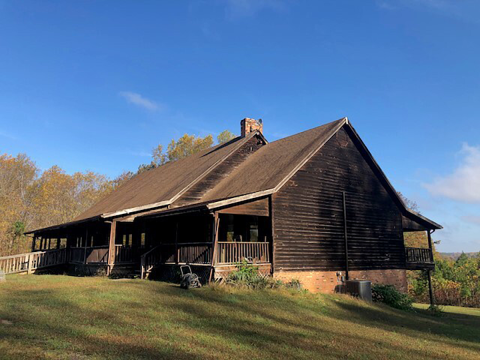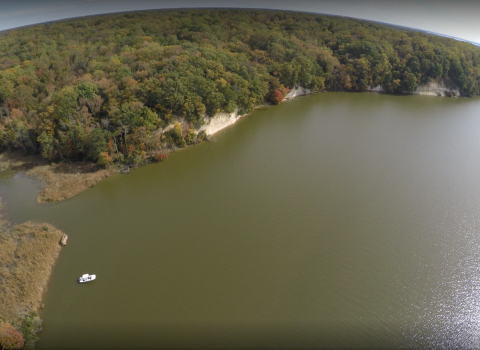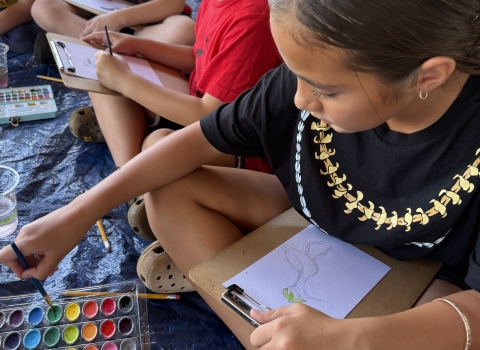A steady drum beat rose under the watchful eyes of native bald eagles, friends and ancestors. For the first time in more than 350 years, the Rappahannock Tribe’s drums sounded over their ancestral capital town.
The Rappahannock River Valley is the ancestral homeland of the federally recognized Rappahannock Tribe, the rising and falling river holding deep significance and importance to the Tribe’s history and culture. The rich ecosystem is diverse in wildlife and habitats, which the Tribe has been stewarding since time immemorial.
The Rappahannock River Valley National Wildlife Refuge’s Cat Point Creek Unit became open to the public in 2023. A two-story, 7,520 square-foot Lodge structure stands on the land and ownership was formally transferred from the U.S. Fish and Wildlife Service to the Tribe in coordination with the Bureau of Indian Affairs. The transfer was celebrated with a ceremony in October 2023.
“Cat Point Creek is the site of the Tribe’s ancestral capital town, so being able to share our history and traditional conservation practices with the public at this significant place is especially meaningful for the Tribe in our mission to preserve our culture for future generations,” said Rappahannock Tribal Chief, Anne Richardson.
Upon renovations, the Lodge will serve as an Indigenous Environmental and Conservation Education Center for use by Tribal citizens and the public, to preserve the river culture and share Indigenous knowledge and stewardship of the land through classes, outdoor activities, and exhibits. The programs will also support the Tribe's longstanding vision to Return to the River, an initiative to engage Tribal youth in leadership skills and traditional cultural knowledge of the river.
Additionally, the center will provide many of the traditional uses the public expects from a national wildlife refuge national wildlife refuge
A national wildlife refuge is typically a contiguous area of land and water managed by the U.S. Fish and Wildlife Service for the conservation and, where appropriate, restoration of fish, wildlife and plant resources and their habitats for the benefit of present and future generations of Americans.
Learn more about national wildlife refuge , like hiking, fishing, birding and kayaking. A new collaborative vision will offer meaningful programming and comprehensive storytelling of the land from 12,000 years ago to the present for an improved visitor experience.
Transferring ownership of the building to the Tribe is an exciting and innovative example of the Service’s commitment to co-stewardship with Tribal Nations.
“Relationships, knowledge-sharing and co-stewardship with Indigenous peoples are essential to the Service mission,” said U.S. Fish and Wildlife Service Director Martha Williams. “The transfer of Cat Point Creek Lodge to the Tribe is a prime example of the collaboration between the Service and Tribes to protect cultural, trust, and treaty resources on Service lands, in support of our shared priority of conserving fish, wildlife, and their habitats.”
Over the last two years, the Department has celebrated several significant and innovative co-stewardship arrangements providing Tribes a greater role in the management of federal lands and waters that have cultural and natural resources of significance. In April 2022, Secretary of the Interior Deb Haaland and Service Director Martha Williams celebrated the Rappahannock Tribe’s re-acquisition of 465 acres at Fones Cliffs.
The Lodge will also serve as the offices of the Tribe’s River Programs and Environmental and Natural Resources departments, working closely with the refuge in a partnership to protect the Tribe’s ancestral lands along the river.
“Our work at the Bureau of Indian Affairs is to enhance the quality of life, promote economic opportunities, and carry out the responsibilities to protect and improve the trust assets of American Indians, Indian Tribes and Alaska Natives,” said BIA Director Darryl LaCounte. “This successful transfer not only upholds our trust responsibilities but demonstrates that by working together, all can benefit equally.”
As we celebrate the successful transfer of Cat Point Creek Lodge to the Tribe, the Service remains committed to fulfilling our trust responsibility to Tribal Nations and growing our partnerships to best serve wildlife and people.







